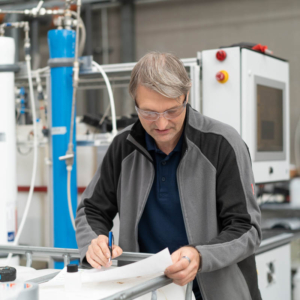Ion exchange (IEX)
Ion exchange technology is a well known and widely used technology: it can be used classically for softening water, on a large scale in the application of deionised water production, but also on a small scale in the dishwasher in almost every household. Ion exchange usually takes place between an ionic group bound to a solid phase and mobile ions in a solution. As a rule, ion exchangers are small spheres made of a polymer matrix that carry firmly bound ionic groups as a so-called functional group. Depending on the type of functional group, a distinction is made between
- Cation exchangers, which carry a bonded acid anion
- Anion exchangers that carry a bonded base cation or an amine function
- Selective ion exchangers that have chelating/complex-forming functional groups.
Crucially, the behaviour of the functional groups can change depending on the external pH. This is used for operation.
Ion exchange is based on the fact that not all ions bind equally well to the respective functional group: The stronger binding ion displaces the weaker ion from the binding site.
In the picture, ion exchange is explained using the example of a cation exchanger:
Crucially, the behaviour of the functional groups can change depending on the external pH. This is used for operation.
Ion exchange is based on the fact that not all ions bind equally well to the respective functional group: The stronger binding ion displaces the weaker ion from the binding site.
In the picture, ion exchange is explained using the example of a cation exchanger:
Calcium and magnesium bind better to the functional group, sodium is released into the water. The outflowing water is free of calcium and magnesium, scale formation no longer takes place in the further course of the pipelines.
If all the binding sites are occupied by calcium or magnesium, the ion exchanger must be regenerated with e.g. sodium chloride (table salt).
The same principle can also be used for very special applications for the extraction or selection of chemical molecules. We have experience with applications in biochemistry, organic chemistry, metal surface technology, waste water treatment, and much more.
Adsorption
In contrast to ion exchange, adsorbents are mostly used to remove organic substances from liquids. There are many different materials:
- The classic activated carbon, which is available in many different variations.
- Polymeric adsorbents, which usually do not have any functional groups.
- Anion exchangers that bind both by ion exchange and adsorption
In general, the adsorption of organic substances onto the inner surface of the adsorbent is used. Therefore, surface properties, porosity, pore size and the material of the adsorbent itself are important for the binding properties.
The regeneration of an adsorbed substance varies greatly and depends on the type of bond.
Usually steam or solvents are used. However, irreversible binding can also occur. Often acid or alkali are also suitable.
Compared to activated carbon, the properties of a polymeric adsorbent change less over time of use because the pore structure is more stable than in many activated carbon products.
Nanofiltration (NF)
Why does MionTec also develop nanofiltration applications?
Nanofiltration is not filtration in the conventional way. The special feature of nanofiltration membranes is their ion selectivity.
Comparable to ion exchange resins, there are also selectivity sequences for retention for nanofiltration.
For the anions, the retention increases according to the following series:
NO3– , Cl–, OH–, SO4–, CO32- …….
For the cations, the retention increases according to the following sequence:
H+, Na+, K+, Ca2+, Mg2+, Cu2+ ……..
The difference to ion exchange is that in nanofiltration there is no ion exchange when passing through a column, but a separation into two fractions: retentate and permeate.
Due to fixed ions in the membranes, the Donnan exclusion can be used for the separation of substances.
For organically neutral components, the electrical interactions are omitted, but size exclusion remains. According to their molecular weight, molecules larger than 200 g/mol are almost completely retained.
If you would like to take advantage of the special properties of nanofiltration, please contact us.
Especially in combination with ion exchange processes, NF can often show its strengths
Forward-Osmosis (FO)
H Hydraulic pressure-driven processes often have the disadvantage of extreme organically induced membrane fouling. Especially in applications where such fouling clogs the membrane in minutes, we are very successful with the forward osmosis process (e.g. with oily water).
The decisive difference to the hydraulic pressure-driven method is that it is not the water that is forced through the membrane (and all accompanying substances follow the same pressure), but that water is sucked through the membrane by an osmotic pressure. To be more precise, only water. The driving force is caused by a draw solution on the opposite side of the membrane. Due to a high salt content, it has a high osmotic pressure, which attracts water to balance this pressure.
The technical challenge in this process is, on the one hand, the selection of suitable membranes and, on the other hand, the maintenance of the high salt concentration in the draw solution when water is permanently passing through the membrane.
Would you like to learn more about our processes? Then please contact us.
Electrodialysis (ED)
Electrodialysis (ED) is also not hydraulic-pressure driven. The driving forces for ions are exerted by an electric field. This results – similar to forward osmosis – in no driving force for e.g. oils, fats and organic substances of many kinds. Only ions are moved in the electric field. At the same time, cations and anions move in different directions. This behaviour is known from water electrolysis, except that in ED individual partial currents are generated through several ion-selective membranes, which only contain one type of ion. Thus, an acidic (containing acids) and an alkaline (containing bases) stream are obtained separately from a saline input stream. This has made it possible to solve a wide variety of desalination processes and separation tasks.
We have a wide range of experience in this field, also in combination with forward osmosis or ion exchange. Curious? Then click here!
This post is also available in: German




